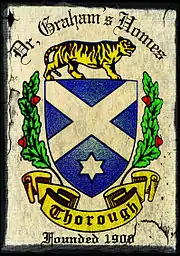Dr. Graham's Homes
Dr. Graham's Homes (formerly St. Andrew's Colonial Homes) was founded in 1900 by Reverend Dr. John Anderson Graham, a missionary of the Church of Scotland, who settled in Kalimpong and worked with the local community for several years during the turn of the 20th century. Whilst working in Edinburgh as a clerk in the Civil Service, Graham was influenced and encouraged by the Minister of his Church, the Reverend John McMurtrie, to be ordained in the Ministry of God.
| Dr. Graham's Homes | |
|---|---|
 | |
| Location | |

| |
| , West Bengal27.0841,88.4922 | |
| Coordinates | 27.0841°N 88.4922°E |
| Information | |
| Former name | St. Andrew's Colonial Homes |
| Type | Boarding and day school |
| Motto | Thorough |
| Established | 1900 |
| Founder | Reverend Dr. John Anderson Graham |
| President | Dr. (MS) Gilian Rosemary Hart |
| Principal | Neil C Monteiro |
| Headmaster | Praveen Pradhan |
| Gender | Co-educational |
| Colour(s) | Blue and White |
| Revenue | Rs. 110,187,099.87 (31 March 2015)[1] |
| Website | www |

History
Rev. John Anderson Graham arrived in Kalimpong in 1889 as a representative of Young Men's Guild of Scotland to do missionary work in the small village of Kalimpong which had recently been annexed by the British from Bhutan after the Dooars War of 1864–1865. In only a few years after arriving in Kalimpong Mr. Graham had turned into a social reformer who aimed to find a solution to what contemporary observers at that time called the "poor white problem" of British India.[2] The "poor whites" were unacknowledged mixed race children of British fathers and "native" mothers.[3] Shunned by the British and the upper class Indians most mixed-race children ended up on city streets. Newspapers, administrators and commentators portrayed this as an acute problem that threatened existing social and racial hierarchies. One solution took the form of St. Andrew's Colonial Homes in Kalimpong, where the pure air of the Himalayas would assist in schooling "poor white" children into a useful workforce.[4]
| Places in the Kalimpong Sadar subdivision in Kalimpong district CT: census town, R: rural/ urban centre, M: municipality, F: facility, NP: national park Abbreviations used in names – TG for Tea Garden (town/village) Owing to space constraints in the small map, the actual locations in a larger map may vary slightly |
On September 24th, 1900, Reverend John Anderson Graham opened St. Andrew's Colonial Homes on land leased from the Government of Bengal below Deolo hill in a rented cottage with 6 children. He would soon lease 100 acres and then over the years a total of 400 acres as the Homes continued to grow. The Homes were established as a vocational training school where abandoned children of British army personnel, administrators and tea planters would be taught a vocation and shipped to British colonies such as New Zealand, Australia and Canada where they could establish themselves with the job skills learned in Kalimpong.[5]
In 1901 the first cottage was opened: Woodburn Cottage, named after the Lieutenant Governor of Bengal subsequent cottages thereafter were named after key benefactors – including Elliot Cottage opened 1902; Campbell Cottage named after Dr. J. A. Campbell, a Member of Parliament; Strachan Cottage was inaugurated in 1904 by Sir Robert Laidlaw of Whiteway, Laidlaw & Co., who had extensive interests in tea and rubber, who, on his death, left money to the Homes.
By 1906 there were 187 children at the Homes. By the 1920s the Homes complex was a self sufficient village housing 600 children which featured a Hospital, Gymnasium and a Farm.[2] In the first twenty years, Mr. Graham constructed 44 buildings averaging a shade over two buildings a year. In the day-to-day running of the Homes, he was greatly helped by two long-serving members of staff: Headmaster, James Simpson and Administrator, James Purdie. Graham's wife Katherine died in 1919, and it was after this he revived his dream of building a Chapel on the compound. This was completed in 1925 and dedicated as the Katherine Graham Memorial Chapel on 24 September, the Homes Silver Jubilee birthday.[6] Mr. Graham completed his last building the Kindergarten, in 1938. The following year was his personal Jubilee year (1889-1939) and well-wishers worldwide contributed to the building of a new Principal's house on the compound. Jubilee House still commemorates him.[7] Dr. Graham passed away on 15 May 1942 and is buried on the Homes compound in the Garden of Remembrance alongside his beloved Katherine.
St. Andrew's Colonial Homes became Dr. Graham's Homes in 1947, to honour the founder.
Notable alumni
- Norman Douglas Hutchinson, British Royal painter
- Lyonchen Jigmi Yoser Thinley, Prime Minister of Bhutan between 2008-2013
- Tshering Tobgay, Prime Minister of Bhutan from 2013 to 2018
- David R. Syiemlieh, Indian academician and the former Chairman of the Union Public Service Commission of India
- Anirban Bhattacharyya, Indian Author, Television Producer & Director, Standup comedian, and Actor
- Binod Pradhan, Bollywood Cinematographer
Gallery
See also
References
- "Income and Expenditure". Dr. Graham's Homes. Retrieved 25 May 2018.
- Viehbeck, Markus (2017). Transcultural Encounters in the Himalayan Borderlands : Kalimpong as a “Contact Zone". Heidelberg University Publishing (heiUP). ISBN 9783946054573.
- Viehbeck, Markus (2017). Transcultural Encounters in the Himalayan Borderlands : Kalimpong as a “Contact Zone". Heidelberg University Publishing (heiUP). ISBN 9783946054573.
- "Heidelberg University Publishing - heiUP". heiup.uni-heidelberg.de. Retrieved 26 September 2019.
- "Heidelberg University Publishing - heiUP". heiup.uni-heidelberg.de. Retrieved 26 September 2019.
- "About Dr. Graham". Dr Graham's Homes. Retrieved 26 September 2019.
- "About Dr. Graham". Dr Graham's Homes. Retrieved 26 September 2019.




